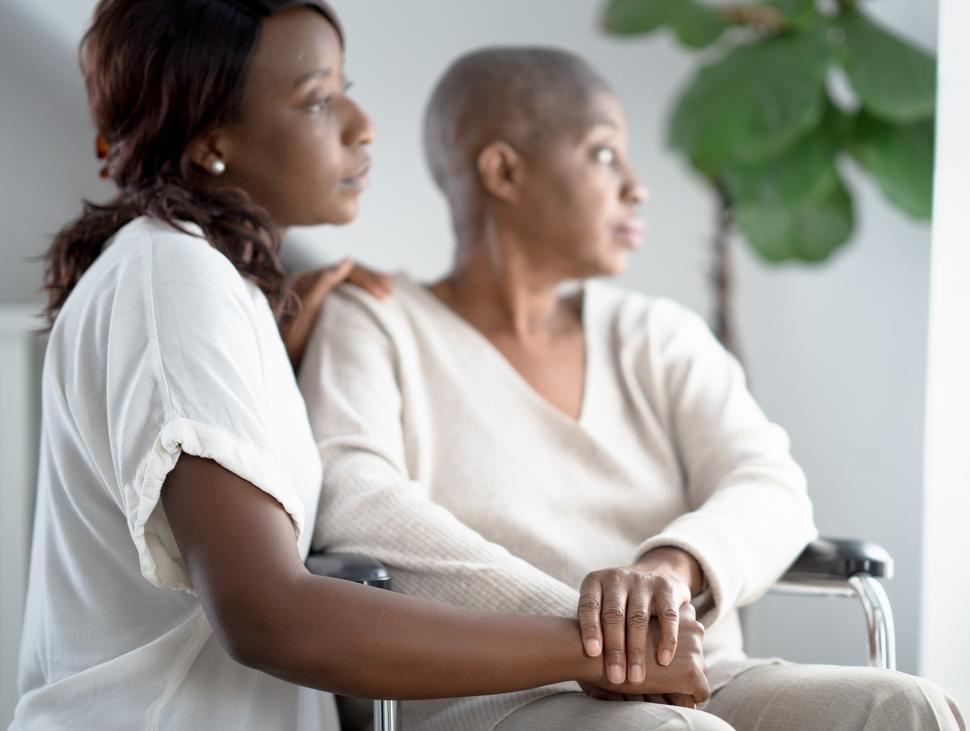Study Finds Shortcomings in Monitoring Caregivers' Emotional Health
, by Sharon Reynolds
Getting a diagnosis and undergoing treatment for a serious illness like cancer rank as some of life’s most stressful experiences. Over the last decade, it’s been increasingly recognized that distress can have an impact on a patient’s health. Asking people with cancer about their emotional health—and treating distress—has become an integral part of cancer care.
But another population can experience substantial distress stemming from the fallout of a cancer diagnosis: family members and loved ones who act as caregivers.
And progress in identifying caregivers in distress and pointing them toward help lags far behind the advances in helping patients, according to results from a new study published September 21 in the Journal of the National Cancer Institute.
In a survey of more than 100 community cancer clinics across the United States, only 16% reported that they routinely screened caregivers for distress, and less than 13% had a strategy in place to refer those in need to mental health and other services, the study showed. In contrast, more than 90% regularly screened patients for distress and provided referrals to supportive care services.
Distress can harm a caregiver’s mental and physical health and may also affect the loved one with cancer they’re caring for, explained Chandylen Nightingale, Ph.D., of Wake Forest University, who led the study.
“There’s definitely evidence to suggest that caregiver well-being impacts the ability of people to provide care for their loved ones,” Dr. Nightingale said. “It can impact how well the person with cancer will do emotionally. It can even lead to them having more emergency room visits or longer hospital stays.”
The good news is that systems already exist to capture information on distress for patients. It may just be a question of leveraging them to help caregivers, explained Ann Geiger, Ph.D., from NCI’s Division of Cancer Control and Population Sciences (DCCPS), who was not involved with the study.
“It is a major accomplishment that almost all patients are screened for distress. But it took a long time to get there—it’s not something that happened overnight,” Dr. Geiger explained.
“Getting to widespread screening of caregivers will take time, but this research shows that process has begun.”
Many sources of distress for cancer caregivers
Caregiver distress, which may include symptoms of depression, anxiety, and stress, can arise from many stressors, explained Dr. Nightingale.
“Cancer is often a very abrupt diagnosis and so, oftentimes, caregivers come into the role with little or no preparation or training. That can absolutely be distressing for them,” she said. “Then watching your loved one struggle with cancer treatment and any symptoms they might have, whether they’re physical or emotional, that’s going to be distressing.”
Many caregivers also have to juggle their own challenges, such as a job and childcare, in addition to caretaking, explained Michelle Mollica, Ph.D., of DCCPS, who was also not involved in the study.
“There’s so much uncertainty in cancer, and that often transfers to the caregiver,” Dr. Mollica said. “What will your partner or loved one need at any given moment? And how does that impact you and your ability to do things like work or take care of yourself, your finances?”
Services exist to help caregivers deal with or lessen their distress, including referring people to mental health care or a formal support group, or providing help accessing financial resources. But caregiver programs are not universally available, and how often caregivers in need get linked to such services isn’t well documented.
Tracking cancer caregiver screening in the community
To take the pulse of how caregiver distress is being identified and managed nationwide, Dr. Nightingale and her colleagues tapped into the NCI Community Oncology Research Program (NCORP), which brings cancer research to community-based cancer clinics across the United States. Around 1,000 community clinics currently participate in the program.
For their study, the researchers recruited 111 NCORP community oncology clinics from across the country. Between 2019 and 2020, a designated staff member at each clinic provided information on whether they had a mechanism in place to identify a primary caregiver for each patient, and whether they screened patients and their identified caregiver for distress.
Respondents also provided information on the primary strategies they used to help patients and caregivers in distress when they were identified.
About two-thirds of the 111 clinics reported that they had a mechanism in place to identify a primary caregiver for patients, and, of these, most had the ability to document if there was more than one caregiver.
Although 65% of practices routinely identified informal caregivers, which is an increase from just a few years ago, it’s not 100%, explained Dr. Mollica. “That’s still a huge initial issue,” she said. “If you haven’t identified caregivers, how are you going to assess for distress and support them?”
And although 99 practices routinely screened patients for distress, only 17 routinely screened caregivers. Of the 17 that did, the screening process usually happened during a patient’s treatment sessions.
Fourteen of the 17 practices that did screen caregivers had a comprehensive referral strategy in place, most often pointing caregivers to an on-site counselor or mental health professional.
Awareness and resources for cancer caregivers
Almost two-thirds of the surveyed practices endorsed the statement that caregivers should be screened regularly for distress from the point of cancer diagnosis onward. So why is the actual rate of caregiver screening so low?
It’s likely a combination of a lack of resources and awareness, explained Dr. Nightingale. “Our health care systems are really set up to treat and support patients,” she said.
But there’s an increasing recognition of the important role caregivers play and the fact that they too can struggle, she continued. “So I think … we’re going to see more progress in this area for caregivers.”
This recognition includes legislation called the Caregiver Advise, Record, and Enable (CARE) Act of 2016, which has been enacted in some form by more than 40 states in the United States to date. The CARE Act requires hospitals to identify a caregiver for every patient and provide the training they need before their loved one is discharged to their care. And in 2022, the Department of Health and Human Services released a National Strategy to Support Family Caregivers.
Researchers are working on ways to better use existing technology to make the screening process easier for overstretched community clinics. For example, Dr. Nightingale’s team is launching a clinical trial that will test a tool to help NCORP clinics automatically screen caregivers in distress, identify their specific needs, and refer them to available resources.
“We’re focusing first on lung cancer, but [the tool] is designed such that it could be generalized to any cancer caregiver population, and that would be our long-term goal,” she said.
Identifying resources for caregivers may be the next challenge, explained Dr. Geiger. “We have places in this country with substantial shortages of behavioral medicine practitioners and other mental health specialists,” she said. “So clinicians may hesitate to screen caregivers unless they have resources to offer them.”
For overwhelmed caregivers today, Dr. Nightingale recommends reaching out to their loved one’s care team if they’re not asked about their mental health.
“What they’re feeling is absolutely normal, and they’re not alone in feeling that way,” she said. “There are resources out there that have been developed specifically to help cancer caregivers just like them. So [talk to] a social worker, or a patient navigator, or a nurse—those are all great places to start.”

